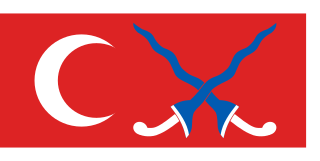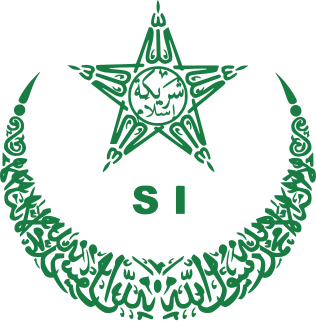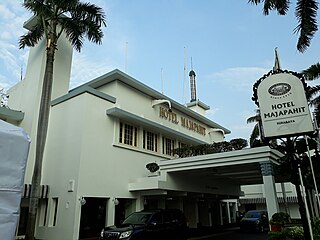
Surabaya is the capital of the Indonesian province of East Java. Located on northeastern border of Java island, on the Madura Strait, it is one of the earliest port cities in Southeast Asia. According to the National Development Planning Agency, Surabaya is one of the four main central cities of Indonesia, alongside Jakarta, Medan, and Makassar.The city has a population of 2.89 million within its city limits in 2019 and 9.5 million in the extended Surabaya metropolitan area, making it the second-largest metropolitan area in Indonesia.

Batavia, also called Batauia in the city's Malay vernacular, was the capital of the Dutch East Indies. The area corresponds to present-day Jakarta, Indonesia. Batavia can refer to the city proper or its suburbs and hinterland, the Ommelanden, which included the much-larger area of the Residency of Batavia in the present-day Indonesian provinces of Jakarta, Banten and West Java.

The Sultanate of Mataram was the last major independent Javanese kingdom on Java before the island was colonised by the Dutch. It was the dominant political force radiating from the interior of Central Java from the late 16th century until the beginning of the 18th century.

Koninklijke Nederlandsch-Indische Luchtvaart Maatschappij was the airline of the former Dutch East Indies. Headquartered in Amsterdam, KNILM was not a subsidiary of the better-known KLM, despite the similar name. The airline had its headquarters in Amsterdam and an office in on the grounds of Tjililitan Airfield in Batavia.

Sultan Hanyakrakusuma is known as Sultan Agung was the third Sultan of Mataram in Central Java ruling from 1613 to 1645. A skilled soldier he conquered neighbouring states and expanded and consolidated his kingdom to its greatest territorial and military power.

The history of the Jews in Indonesia began with the arrival of early European explorers and settlers, and the first Jews arrived in the 17th century. Most of Indonesian Jews arrived from Southern Europe, the United Kingdom, the Netherlands, Belgium, Germany, France, Middle East, Northern Africa, India, China and Latin America. Jews in Indonesia presently form a very small Jewish community of about 100–550, of mostly Sephardi Jews. Judaism is not recognized as one of the country's six official religions, and members of the local Jewish community have to register as Christian or another recognized religion on their official identity cards.

Sarekat Islam or Syarikat Islam was an Indonesian socio-political organization founded at the beginning of the 20th Century during the Dutch colonial era. Initially, SI served as a cooperative of Muslim Javanese batik traders to compete with the Chinese-Indonesian big traders. From there, SI rapidly evolved into a nationalist political organization that demanded self-governance against the Dutch colonial regime and gained wide popular support. SI was especially active during the 1910s and the early 1920s. By 1916, it claimed 80 branches with a total membership of around 350,000.

Many Armenian merchants from Amsterdam went to Southeast Asia in the 19th century to trade, and to set up factories and plantations. Armenian merchants settled in parts of Java, then part of the Dutch East Indies, as did Armenians moving east from the Persian Empire, establishing a community of Armenians in Java.

The Hotel Majapahit is a historic hotel in Surabaya, East Java, Indonesia, opened in 1911.

The Dutch East Indies was a Dutch colony consisting of what is now Indonesia. It was formed from the nationalised colonies of the Dutch East India Company, which came under the administration of the Dutch government in 1800.
Bersiap is the name given by the Dutch to a violent and chaotic phase of the Indonesian National Revolution following the end of World War II. The Indonesian word bersiap means 'get ready' or 'be prepared'. The Bersiap period lasted from August 1945 to December 1946.

Dutch colonial architecture in Indonesia were built across the archipelago that once was known as Dutch East Indies. Most of the better and permanent colonial era structures are located in Java and Sumatra, which were economically considered more important during the Dutch imperial period. As a result, there are large number of colonial buildings concentrated in its cities. Plenty of old VOC era forts and warehouses are also scattered throughout the archipelago, particularly around Maluku Islands and Sulawesi. There are three Dutch colonial architectural styles:

Roekiah, often credited as Miss Roekiah, was an Indonesian kroncong singer and film actress. The daughter of two stage performers, she began her career at the age of seven; by 1932 she had become well known in Batavia, Dutch East Indies, as a singer and stage actress. Around this time she met Kartolo, whom she married in 1934. The two acted in the 1937 hit film Terang Boelan, in which Roekiah and Rd Mochtar played young lovers.

Tio Ie Soei was a peranakan Chinese writer and journalist active in the Dutch East Indies and Indonesia. Born in the capital at Batavia, Tio entered journalism while still a teenager. By 1911 he had begun writing fiction, publishing Sie Po Giok – his first novel – that year. Over the next 50 years Tio wrote extensively in several newspapers and magazines, serving as an editor for some. He also wrote several novels and biographies, including ones on Tan Sie Tat and Lie Kim Hok.

Tirto Adhi Soerjo was an Indonesian journalist known for his sharp criticism of the Dutch colonial government. Born to a noble Javanese family in Blora, Central Java, Tirto first studied to become a doctor but later focused on journalism. A freelancer since 1894, in 1902 he was made an editor of the Batavia based Pembrita Betawi. Tirto established his first newspaper in 1903 and, four years later, created Medan Prijaji as a medium for educated native Indonesians. This proved his longest-lived publication, lasting over five years before Tirto was exiled in 1912 to Bacan for his staunch anti-colonial criticism.

Ismail Djoemala was an Indonesian actor active in the 1940s. He was often cast alongside Roekiah as her romantic interest.

Soeara Berbisa is a 1941 film from the Dutch East Indies. Produced by Ang Hock Liem for Union Films and directed by R Hu, this black-and-white film stars Raden Soekarno, Ratna Djoewita, Oedjang, and Soehaena. The story, written by Djojopranoto, follows two young men who compete for the affections of a woman before learning that they are long-lost brothers.

Footsteps is the third novel in the Buru Quartet tetralogy by the Indonesian author Pramoedya Ananta Toer. The tetralogy fictionalizes the life of Tirto Adhi Soerjo, an Indonesian nobleman and pioneering journalist. This installment covers the life of Minke – the first-person narrator and protagonist, based on Tirto Adhi Soerjo – after his move from Surabaya to Batavia, the capital of Dutch East Indies. The original Indonesian edition was published in 1985 and an English translation by Max Lane was published in 1990.
Major General (Retired) Muhammad Mangundiprojo was a 20th-century Indonesian soldier, revolutionary, and civil servant. Born in Sragen Regency on the island of Java, Mangundiprojo joined a nationalist group during the Second World War. He later fought against the return of Dutch colonial authority to Indonesia, and later went on to become a politician. He died in Bandar Lampung in 1988.
Sin Po was a Peranakan Chinese Malay-language newspaper published in the Dutch East Indies and later Indonesia. It expressed the viewpoint of Chinese nationalism and defended the interests of Chinese Indonesians and was for several decades one of the most widely read Malay newspapers in the Indies. It existed under various names until 1965.


















